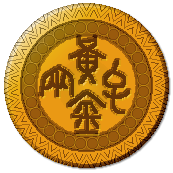Tael (Themiclesian coin)
| Value | 1⁄20 Qik |
|---|---|
| Mass | 21.9 g |
| Diameter | 35.4 mm |
| Thickness | 1.82 mm |
| Edge | Milled |
| Composition | .875 Au .125 Cu |
| Gold | 0.6169 troy oz |
| Years of minting | 782 |
| Obverse | |
 | |
| Design date | 805 |
| Design discontinued | 1227 |
| Reverse | |
The Tael or Polaris is a Themiclesian gold coin, valued at 1⁄20 qik or 24 mace.
It was first minted in 782 under Emperor Snang and saw considerable domestic and foreign circulation, reaching as far as Casaterra.
History
Medieval
The Tael piece was the first gold coin minted in the modern disc shape in Themiclesia. Though historical documents do not record the year it entered circulation, it is generally agreed it was introduced in 782 under Emperor Snang of the Dzi dynasty. International commerce between Themiclesia and the Meridian states began in earnest earlier in the century, calling for a coin of convenient shape and dependable fineness. Much of the trade in the first decades of the 8th century was under the royal household, though private trade quickly overtook it in volume.
Earlier Themiclesian coins, weighing nearly 400 grams and resembling medals, were originally cast for transfer payments between government departments and as ceremonial gifts in state and diplomatic functions. In ordinary trade, they were too large, which required them to be cut and measured. The alternative was bronze coins, which conversely was too heavy over long distances and was not widely accepted outside of Themiclesia. The new gold coin was 1⁄20 of the old and was minted with a clear pattern and within tighter tolerances, making forgeries more easily detected and boosting confidence in its fineness.
The Tael piece was cast with indentations and inscription, but a intricate and characteristic "halo" was added by striking the coin with a steel die. The geometric pattern served to accentuate efforts at clipping and was difficult to forge by sand casting. This did also meant that the cast blank must align with the die precisely, or the "halo" would be off-centre and make the coin appear clipped. A number of coins were rejected prior to issue and were found at former mint sites, though their high value meant that most mint errors were melted down.
The gold Tael piece was widely circulated in Themiclesia, exchanging for 1,000 bronze coins of the same weight on average, though it dipped as low as 560 coins in the early 11th century and was as high as 1,500 towards the 19th century.
Other denominations such as the Double Tael, valued 1⁄10 qik, and Half Tael, at 1⁄40 qik were issued in imitation of the Tael piece and shared similar aesthetics; however, the most widely accepted coin remained the Tael piece.
Via trade and piracy with Hallia, the Tael coin not only entered Meridia but also Casaterra in the 9th century. The monicker "Polaris" was given to the coin over the shape of the overstruck halo.
Pre-decimalization
After the monetization of silver coins in the late 16th century, the Polaris remained in use but was minted less frequently under the effects of the exportation of gold from Themiclesia. The silver dollar was valued at 1⁄12 the Polaris.
